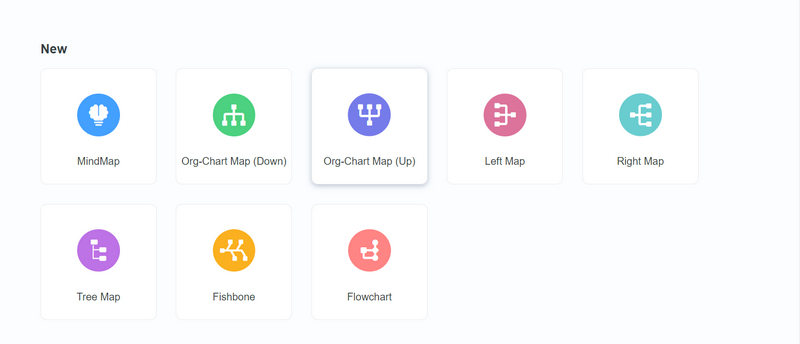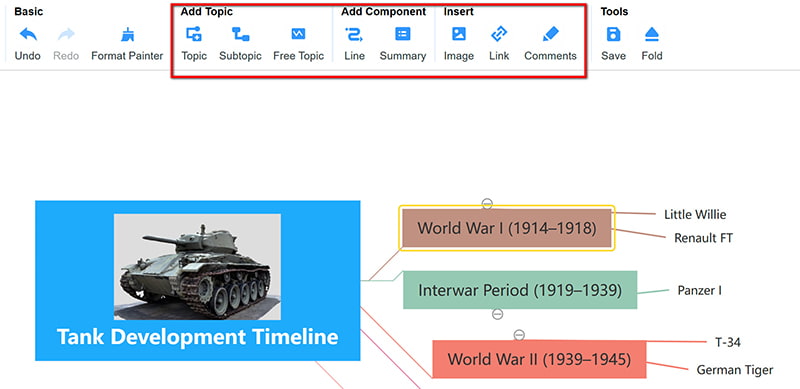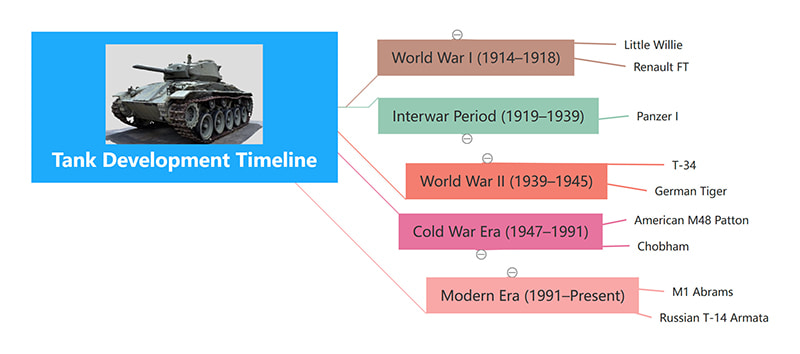Tank Development Timeline: A Journey Through History
If you’ve ever been fascinated by the massive steel machines thundering across battlefields, you’re not alone. Tanks have always been a symbol of military power and technological innovation. In this article, we’ll take a deep dive into the tank development timeline, uncovering its fascinating history and evolution. From their first appearance during World War I to the modern combat machines we see today, tanks have come a long way. Let’s explore this timeline evolution of tanks, and learn about their key differences across eras.

- Part 1. Who Invented the First Tank on Earth?
- Part 2. The Tank Development Timeline
- Part 3. How to Make a Tank Development Timeline
- Part 4. Differences Between Modern and WWII Tanks
- Part 5. FAQs About Tank Development Timeline
Part 1. Who Invented the First Tank on Earth?
The story of tanks begins with the grim trenches of World War I. The first tank, named ‘Little Willie,’ was developed by the British in 1915. Designed to break the stalemate of trench warfare, this prototype was far from the sophisticated machines we know today. With a top speed of just 2 miles per hour and an awkward design, it laid the foundation for what would become a crucial weapon of war.
The British military followed up with the ‘Mark I,’ the first tank to see combat in 1916 at the Battle of the Somme. Though rudimentary, it demonstrated the potential of armored vehicles to revolutionize warfare.
A Quick Look at Early Tank Developers:
Britain: Produced the first functional tank and used it in combat.
France: Introduced the Renault FT in 1917, a design that set the standard with its turret-mounted gun.
Germany: Initially lagged but later created formidable tanks during WWII.
Part 2. The Tank Development Timeline
Now, let’s trace the tank history timeline from its beginnings to the present.
1. World War I (1914–1918)
1915: The prototype ‘Little Willie’ is created.
1916: Mark I, the first operational tank, is deployed at the Battle of the Somme.
1917: The French Renault FT introduces the first rotating turret.
If you are interested in French history, check this timeline here to get more details including its tank information.
2. Interwar Period (1919–1939)
1920s: Improvements in suspension and armament are made, leading to tanks with better mobility and firepower.
1930s: Germany begins secretly developing tanks, such as the Panzer I, despite restrictions from the Treaty of Versailles.
3. World War II (1939–1945)
Early war: Germany introduces the Panzer III and IV, while the Soviet Union deploys the robust T-34.
Mid-war: Heavy tanks like the German Tiger and Panther enter the battlefield, showcasing increased armor and firepower.
End of war: Allied forces rely on versatile tanks like the Sherman to secure victory.
4. Cold War Era (1947–1991)
1950s: Main Battle Tanks (MBTs) like the American M48 Patton and Soviet T-54 become standard.
1970s: Introduction of advanced features like composite armor (Chobham) and guided missiles.
5. Modern Era (1991–Present)
1990s: The Gulf War demonstrates the dominance of modern tanks like the M1 Abrams.
2000s: Tanks incorporate advanced electronics, thermal imaging, and reactive armor.
Today: Cutting-edge tanks like the Russian T-14 Armata and updated Abrams feature unmanned turrets and AI systems.
Part 3. How to Make a Tank Development Timeline
If you’re looking to visualize the evolution of tank technology over the years, MindOnMap is the perfect tool to create a professional, easy-to-follow timeline. Here’s a step-by-step guide to get started:
MindOnMap is the ultimate timeline maker for showcasing the evolution of tank development, combining simplicity, creativity, and powerful features to bring history to life. Whether you're mapping out the emergence of early WWI tanks, iconic WWII models, or cutting-edge modern designs, MindOnMap’s intuitive, web-based platform makes it easy to craft stunning, customizable timelines. With drag-and-drop tools, collaborative editing, and full online accessibility, you can seamlessly organize key milestones, add visuals, and highlight innovations with professional flair.
Visualizing history through a timeline makes it easier to understand complex developments. Let’s follow the steps to craft a detailed tank timeline.
Go to the official MindOnMap website and sign up for a free account. If you prefer working offline, download the desktop version for Windows or Mac.
After signing in, navigate to the dashboard to start creating your project.
Select a timeline diagram template. This template will serve as the foundation of your tank development timeline.

This step is the most important part of making a tank development timeline.
1. Add Key Milestones
• For each tank model or significant era (e.g., WWI, WWII, Cold War), add its name, year of introduction, and historical significance.
• Include technical advancements, such as the introduction of rotating turrets, armor plating, or innovative weaponry.
2. Connect related events or innovations:
For instance, link the development of the British Mark I tank in WWI to later models like the Churchill tank in WWII.
3. Enhance with visuals:
• Add photos of tanks, blueprints, or historical maps to make the timeline more engaging..
• Include flags or symbols to indicate the country responsible for each development.

Let’s follow the steps to craft a detailed tank timeline.
Secure Download
Secure Download
Here, you can customize the timeline structure by changing the timeline style, colors, fonts, and background to match your theme.
Alternatively, you can use tank-related imagery or backgrounds to make it visually appealing.

Pro Tips:
• Highlight key events: Emphasize pivotal moments like the debut of the T-34 in WWII or the introduction of modern main battle tanks like the M1 Abrams.
• Use thematic colors: Assign different colors to eras or countries for easy differentiation.
• Insert short descriptions: Provide brief but informative details about each tank's role, features, or impact on warfare.
Once your timeline is complete, review your entries for accuracy and coherence. Then, you can export your work to save it as a PDF or image file (e.g., PNG) for easy sharing or presentation.
Alternatively, generate a shareable link if you’d like to collaborate with others.
Creating a tank development timeline using MindOnMap not only helps organize historical data but also gives you a clearer understanding of how technology has evolved over the years.
Whether you’re a military history enthusiast or a researcher, MindOnMap equips you with everything you need to bring this complex history to life.
Part 4. Differences Between Modern and WWII Tanks
Over the decades, tanks have undergone significant changes. Let’s compare modern tanks with their WWII counterparts:
1. Armor and Protection
WWII Tanks: Relied on steel armor, which was often vulnerable to anti-tank weapons.
Modern Tanks: Use composite and reactive armor, offering enhanced protection against modern threats.
2. Firepower
WWII Tanks: Guns ranged from 37mm to 88mm, with limited accuracy at long distances.
Modern Tanks: Feature smoothbore guns with advanced ammunition like APFSDS (Armor-Piercing Fin-Stabilized Discarding Sabot).
3. Mobility
WWII Tanks: Maximum speeds averaged 20-30 mph, with limited off-road capabilities.
Modern Tanks: Use gas turbine or diesel engines, reaching speeds of 40-50 mph and excelling in varied terrains.
4. Technology
WWII Tanks: Operated manually with basic optical sights.
Modern Tanks: Include thermal imaging, laser rangefinders, and computerized fire control systems.
5. Crew Requirements
WWII Tanks: Required 4-5 crew members to operate.
Modern Tanks: Some, like the T-14 Armata, can operate with a crew of just 3, thanks to automation.
Part 5. FAQs About Tank Development Timeline
When were tanks first used in combat?
Tanks were first used in combat during the Battle of the Somme in 1916.
What is the most famous tank of WWII?
The Soviet T-34 is often considered the most iconic tank of WWII due to its balance of armor, firepower, and mobility.
How have tanks evolved?
Tanks have evolved from slow, lightly armored vehicles in WWI to advanced, heavily armed machines with cutting-edge technology today.
Can I create a tank timeline for free?
Yes! Tools like MindOnMap allow you to create detailed timelines for free.
Are tanks still relevant in modern warfare?
Absolutely. While their roles have shifted, tanks remain crucial for ground dominance and support in combined-arms operations.
Conclusion
Tanks have an incredible history, from their humble beginnings in WWI to becoming symbols of technological advancement and military power. By understanding the tank development timeline, we gain insight into how these machines have shaped warfare and adapted to meet the challenges of their time.
Creating a visual representation of this evolution is both educational and fun, and MindOnMap makes the process simple. So why wait? Dive into history and make your timeline evolution of tanks with MindOnMap today!










